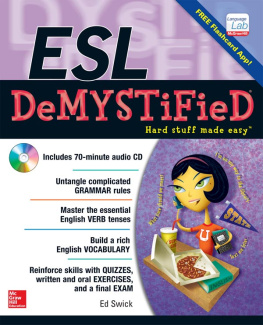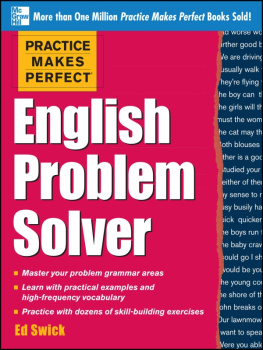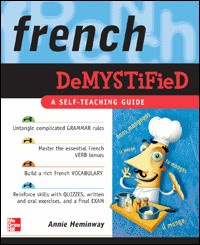ESL DeMYSTiFieD Ed Swick
Copyright 2014 by McGraw-Hill Education. All rights reserved. Except as permitted under the United States Copyright Act of 1976, no part of this publication may be reproduced or distributed in any form or by any means, or stored in a database or retrieval system, without the prior written permission of the publisher. ISBN 978-0-07-182078-3 MHID 0-07-182078-7 The material in this eBook also appears in the print version of this title: ISBN 978-0-07-182077-6 (book and CD set) MHID 0-07-182077-9 (book and CD set) ISBN 978-0-07-182075-2 (book for set) MHID 0-07-182075-2 (book for set) All trademarks are trademarks of their respective owners. Rather than put a trademark symbol after every occurrence of a trademarked name, we use names in an editorial fashion only, and to the benefit of the trademark owner, with no intention of infringement of the trademark. Where such designations appear in this book, they have been printed with initial caps.
McGraw-Hill eBooks are available at special quantity discounts to use as premiums and sales promotions, or for use in corporate training programs. To contact a representative please e-mail us at . TERMS OF USE This is a copyrighted work and The McGraw-Hill Companies, Inc. (McGraw-Hill) and its licensors reserve all rights in and to the work. Use of this work is subject to these terms. Except as permitted under the Copyright Act of 1976 and the right to store and retrieve one copy of the work, you may not decompile, disassemble, reverse engineer, reproduce, modify, create derivative works based upon, transmit, distribute, disseminate, sell, publish or sublicense the work or any part of it without McGraw-Hills prior consent.
You may use the work for your own noncommercial and personal use; any other use of the work is strictly prohibited. Your right to use the work may be terminated if you fail to comply with these terms. THE WORK IS PROVIDED AS IS. McGRAW-HILL AND ITS LICENSORS MAKE NO GUARANTEES OR WARRANTIES AS TO THE ACCURACY, ADEQUACY OR COMPLETENESS OF OR RESULTS TO BE OBTAINED FROM USING THE WORK, INCLUDING ANY INFORMATION THAT CAN BE ACCESSED THROUGH THE WORK VIA HYPERLINK OR OTHERWISE, AND EXPRESSLY DISCLAIM ANY WARRANTY, EXPRESS OR IMPLIED, INCLUDING BUT NOT LIMITED TO IMPLIED WARRANTIES OF MERCHANTABILITY OR FITNESS FOR A PARTICULAR PURPOSE. McGraw-Hill and its licensors do not warrant or guarantee that the functions contained in the work will meet your requirements or that its operation will be uninterrupted or error free. Neither McGraw-Hill nor its licensors shall be liable to you or anyone else for any inaccuracy, error or omission, regardless of cause, in the work or for any damages resulting therefrom.
McGraw-Hill has no responsibility for the content of any information accessed through the work. Under no circumstances shall McGraw-Hill and/or its licensors be liable for any indirect, incidental, special, punitive, consequential or similar damages that result from the use of or inability to use the work, even if any of them has been advised of the possibility of such damages. This limitation of liability shall apply to any claim or cause whatsoever whether such claim or cause arises in contract, tort or otherwise. To obtain material from the disk that accompanies the
printed version of this eBook, please Downloadable MP3 recordings and other supplementary material may be obtained from McGraw-Hill Professionals Media Center at
http://mhprofessional.com/mediacenter.
Enter this eBook's ISBN and your e-mail address at the Media Center to receive an e-mail message with a download link.
This eBook's ISBN is 978-0-07-182078-3.

Contents All languages have rules that govern how the grammar of those languages functions. In all languages, the rules of grammar are sometimes broken, and if a rule is broken often enough and by enough people, a new rule replaces the original one that conforms to the new pattern the people have accepted.
For example, for centuries the verb dive was considered an irregular verb in the past tense (dove) and a regular verb as a past participle (has dived). No one knows for sure why it happened, but the past tense also became dived in North America over the last two centuries. Another such verb is dream. Its past tense and past participle appear in two forms: dreamt and dreamed. You will hear both in most English-speaking countries, and both are considered correct. Why does this occur? The answer is simple: these are the patterns that the speakers of a language use and accept as correct. Those who learn this language must accept these patterns and learn to use them as well.
There is no other concrete answer to why does this occur because other explanations have been obscured by the passage of a great deal of time. How and why a language functions in one way or another is often mysterious. This book will guide you in demystifying a variety of structures and linguistic patterns as you set about improving your English language skills. The first chapter of this book is different from the others. It is a guide to vowel and consonant pronunciation and is provided because the key to speaking and understanding well is pronouncing words correctly. If you develop the habit of pronouncing a word or phrase incorrectly, not only will you be hard to understand, you will also not understand a familiar word or phrase when you hear it pronounced correctly.
This is an important chapter for you if you are determined to improve your accent. Most other chapters describe and illustrate elements of English that often require demystifying. For example, the word his is both a possessive adjective and a pronoun. What is the difference? How is each used? Those questions are answered, and numerous examples are provided. The patterns that are described are then put into practical exercises. The basis of language is speech, so all concepts are practiced not only in written exercises but also in oral exercises.
Each chapter ends with a quiz that will help you to evaluate your understanding of the material covered. The quizzes are open-book quizzesyou should use the content of the chapter as a resource for determining the correct answers. A good suggestion is to achieve a score of at least 80 percent before going on the next chapter. After every five chapters, you will find a Part Test. Its goal is to check whether you have achieved the basics of the content of the five chapters and to give you a way to measure your progress. It is suggested that you consider these tests closed-book tests in order to check your comprehension of the concepts in each part.
You should get a score of at least 75 percent in a Part Test before moving on to the next part. In most chapters, you will encounter a section called Idioms Demystified. The idioms provided are not selected at random but rather because they conform to the concepts of the chapter they are in. The idioms are explained and include several examples of their use. Youll also find sections called Take Note. These boxes highlight important information for your study.
The last chapter of the book is a culmination of the other chapters. The main goal is to give you an abundance of writing practice and opportunities to write creatively. The writing exercises provide guidance on how you should write, but you will be the author of your sentences. The book ends with the Final Exam. This is your measuring tool to determine how much you have improved and how well you can manipulate the concepts that have been demystified. This exam contains fifty questions, and a good score on the Final Exam would be 75 percent or above.













